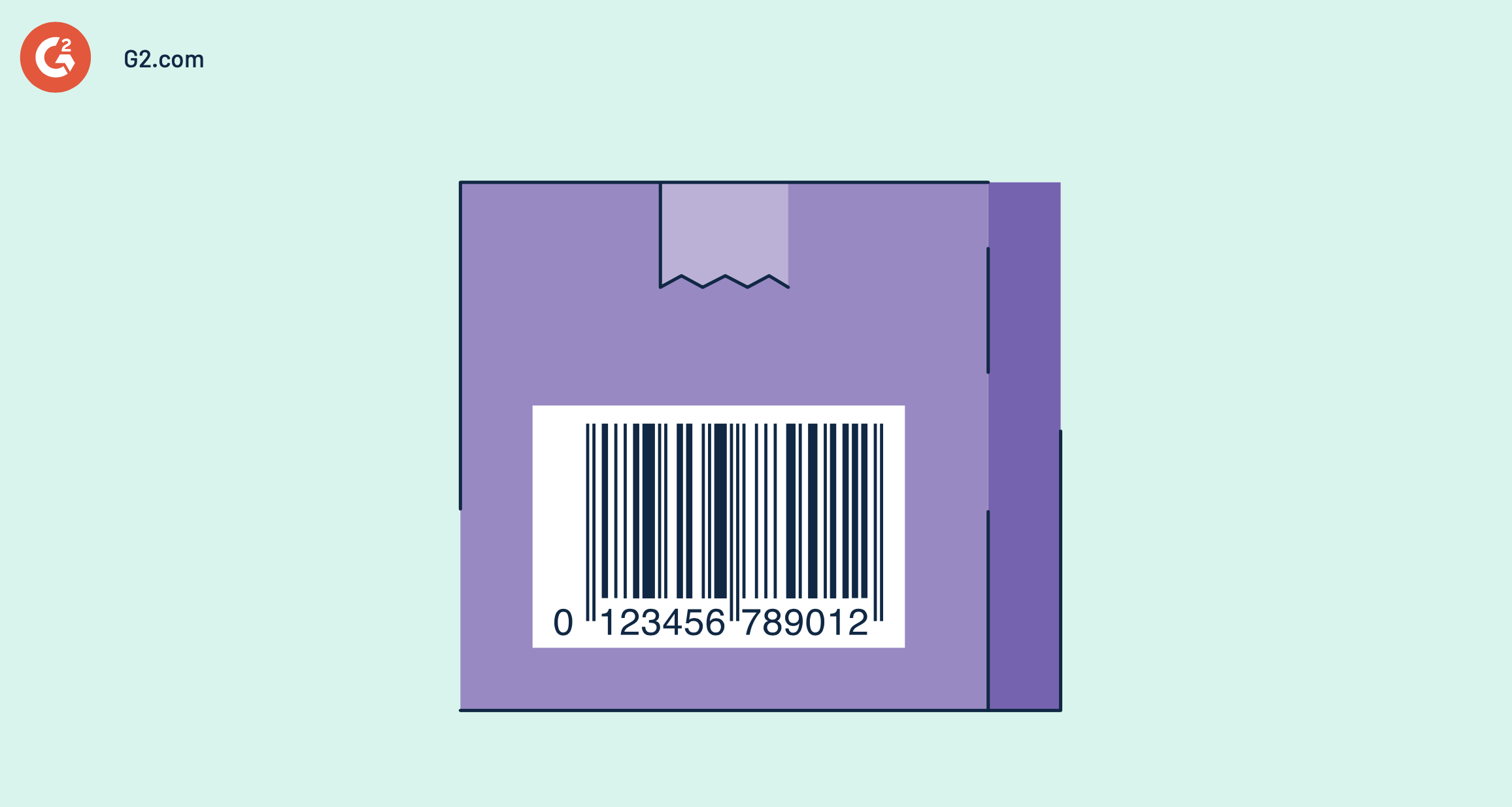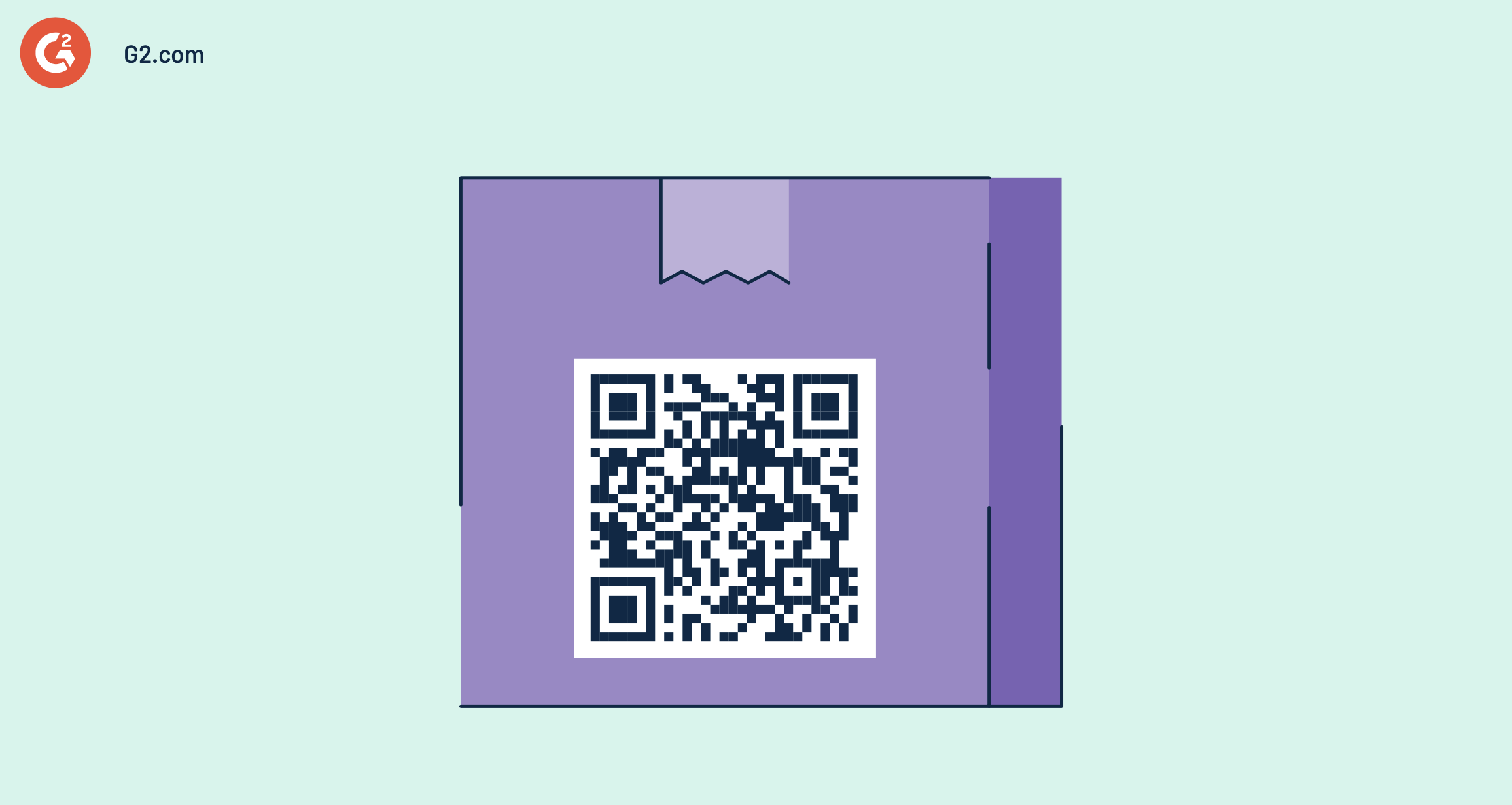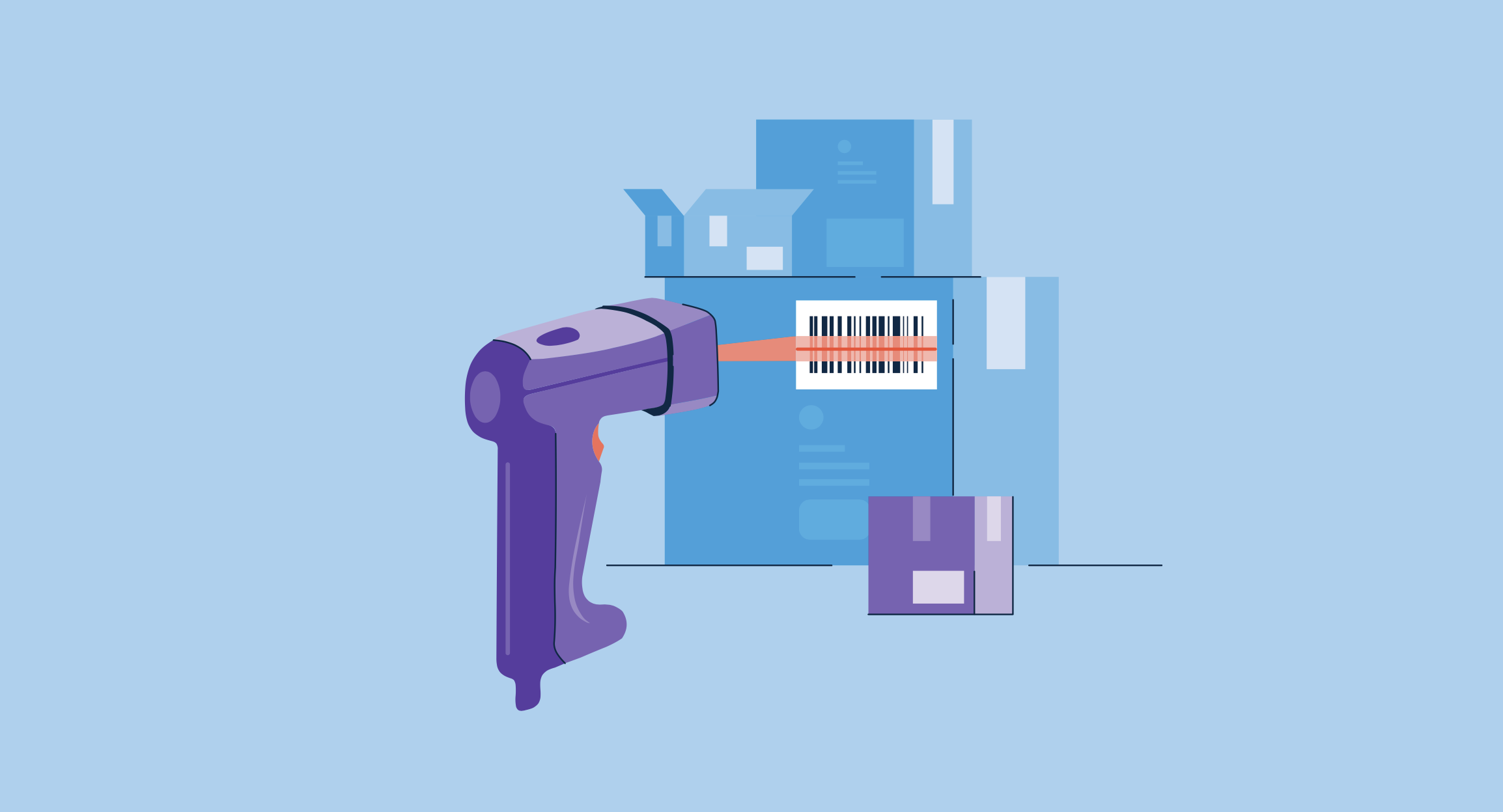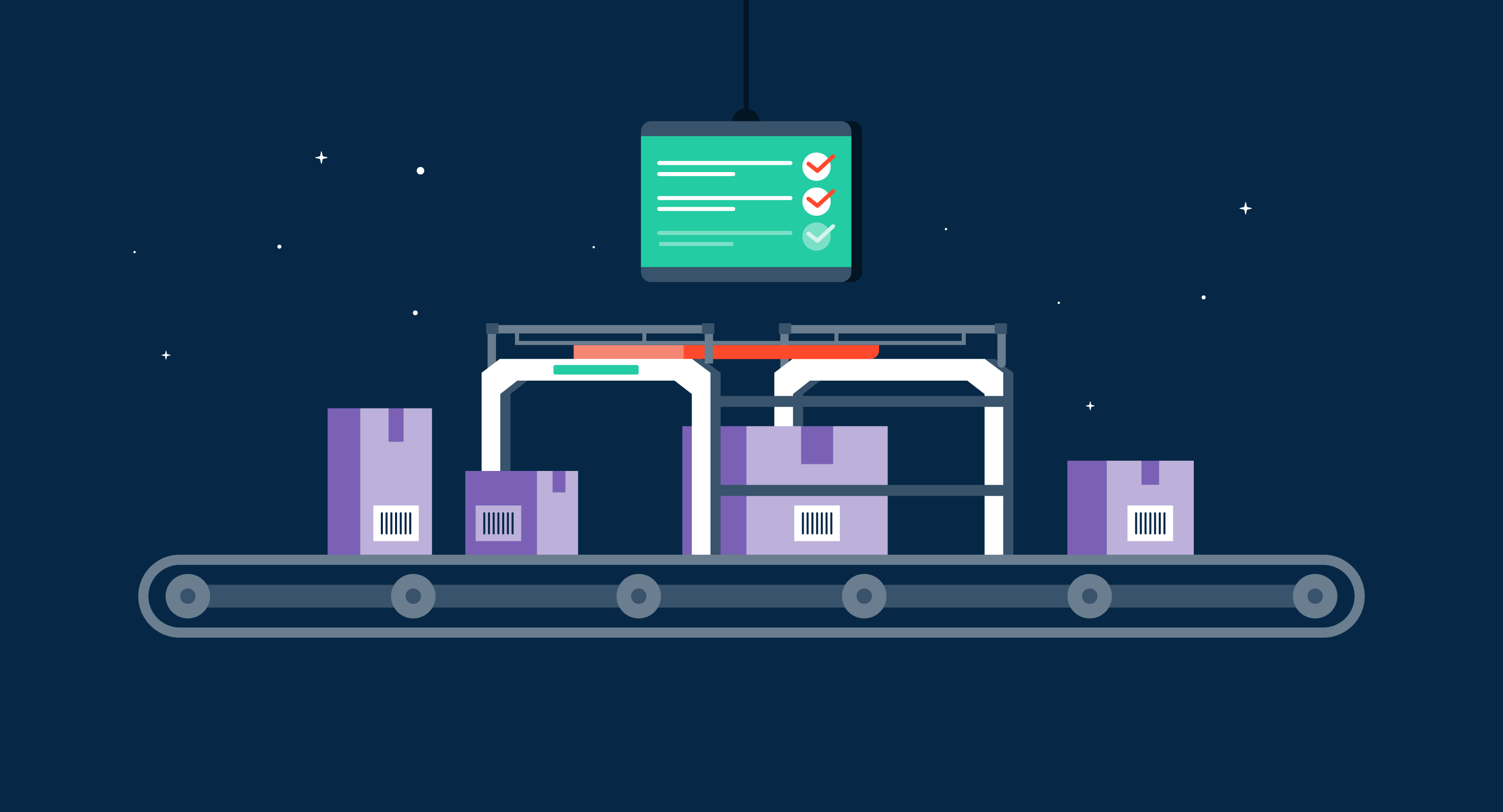Do you like the “beep” noise your items make as they’re scanned at the grocery store? Then boy, do I have the inventory system for you.
A barcode inventory system gives you the power to point at each of your warehouse items and scan your way to a new and improved stock organization method.
What is a barcode inventory system?
A barcode inventory system assigns each inventory item with a barcode sticker that is scanned as it moves through the supply chain.
A barcode uses machine-readable lines, spaces, shapes, and patterns to output some kind of attributed information or data. Every barcode is completely unique and uses numbers and letters to categorize and distinguish different classifications of items.
Most barcodes require specialized scanners to produce information, while some can be scanned with a mobile device's camera.
Businesses use barcode software to create barcodes, interpret the codes on company devices, generate printable templates, assign specific serial numbers to inventory items, and quickly collect data. These tools can work with inventory management systems to keep track of product stock levels and locations and store data safely and accurately.
How does a barcode inventory system work?
The main goal of a barcode inventory system is to have as accurate a stock count as possible. This is done using automation to ensure that data is being recorded in real-time as items move through the entire supply chain.
Barcode inventory systems work with barcode software to create unique labels that are placed on inventory items and scanned to collect accurate stock data. There are different types of barcodes and barcode scanners businesses use to meet different objectives, whether it’s to update their barcodes as infrequently as possible or scan them from up to two feet away.
Businesses of all sizes can benefit from using a barcode inventory system. As a business grows, a barcode inventory system can be especially helpful as stock is moved around the warehouse or across multiple locations. While all inventory systems track assets, send notifications when stock levels are low, and increase inventory security, a barcode system automates all of these processes. This hands-off approach allows companies to worry less about inventory and focus more on production and distribution.
Some companies use warehouse management software (WMS) to keep a closer eye on how items move within the barcode system. WMS also gives companies the ability to manage the warehouse workforce, access data across multiple locations, coordinate shipping processes, and more.
Vous voulez en savoir plus sur Logiciel de gestion des stocks ? Découvrez les produits Contrôle des stocks.
Types of barcodes
There are two different types of barcodes a company can use to implement its barcode inventory system and categorize all in-stock items. Both are effective in their own ways, but one may be a better fit depending on company inventory organization goals.
One-dimensional barcodes
One-dimensional (1D) barcodes are the most common barcodes, usually found on major consumer goods.

Types of 1D barcodes:
- Universal Product Code (UPC): The most popular barcode for North American retail products
- EAN code: Labels consumer goods in Europe
- Code39: Used most commonly in the automotive industry
- Code 128: Used in logistics and transportation industries for ordering and distribution
- ITF: Labels worldwide packaging materials
- Code 93: Provides retail inventory information
- Codabar: Used most commonly in the healthcare industry
- GS1 Databar: Identifies coupons, produce, and perishables
- MSI Plessey: Used for retail inventory management, like supermarket shelf labels
1D barcodes are probably what you think of when you hear the word ‘barcode’, with lines, spaces, and numbers. The numbers can be used to create an organization method unique to your company’s inventory. For example, the barcode numbers can refer to item use or product code.
A 1D barcode scanner reads these elements from left to right. When scanned, the barcode will refer back to the information held in the inventory’s database. This is favorable for companies who make many changes within the database and hope to avoid constantly switching out barcodes.
Two-dimensional barcodes
Two-dimensional (2D) barcodes use different patterns and shapes to hold necessary data.

Types of 2D barcodes:
- Quick Response (QR) code: Used for inventory tracking and advertising
- Datamatrix code: Labels small goods or documents
- PDF417: Used for high data storage, like images
- Aztec: Labels tickets and boarding passes in the transportation industry
The most popular 2D barcode is the QR code. 2D barcodes can typically contain more information than a 1D barcode because they are read vertically and horizontally.
When scanned, 2D barcodes can output images, web addresses, and more. This means that 2D barcodes do not necessarily need to be attached to a database to offer inventory information. This is favorable for companies who want to include large amounts of data within the same size of barcode.
Benefits of a barcode system
A barcode inventory system takes companies one step closer to a more organized and efficient inventory process. Below are other key benefits of implementing a barcode system.
- Save time by skipping the manual inventory counting process. Barcodes count all items immediately, leaving warehouse employees with more time to efficiently fulfill orders.
- Collect data instantly with automation you can trust. Barcode systems allow data to quickly and precisely transfer to all company devices.
- Reduce human error by trusting artificial intelligence to do the heavy lifting. Manual stock entry leaves a lot of room for minor mistakes that become significant issues. Barcodes increase inventory accuracy while keeping the burden of perfection off your employees.
- Improve inventory control by knowing exactly where all stock is being held. Barcodes categorize different classes of inventory and keep track of how they move within the system. Some companies use inventory control software with barcode software to track assets and forecast future inventory needs.
- Lower costs by only purchasing materials you need. The increased accuracy in inventory control will help ensure all re-purchasing information is correct. The decreased chances of human error also helps lower the potential for expensive mistakes.
Check out the best inventory control software for 2025.
Barcode system challenges
Although there are many benefits to implementing a barcode inventory system, there are some challenges a company may face as they implement and maintain the system.
- High initial costs. If you’re a small business with modest inventory levels, the cost of buying and implementing barcode equipment can be more costly than the return on investment is worth.
- Time-consuming installation. While barcodes help save time in the long run, the set up process can be particularly time-consuming. Specifically, a lot of time will be needed to print and place a barcode sticker on every single item in inventory.
- Implementation training. Ensuring all employees are on the same page regarding the new barcode system can also be incredibly time-consuming. Barcoding affects both shipping and receiving processes, so all team members must know how to use the system properly.
- Printing issues. When using a barcode system, you put a lot of trust into barcodes to do the hard part of counting stock. With that said, running into a printing issue when creating the barcodes can cause significant delays in order preparation and shipping.
- Continuous maintenance. Wherever there is technology, there is the need to maintain it. A barcode system will need special attention to ensure all processes are up to date and working appropriately.
How to implement a barcode system for inventory
Once you have determined that a barcode inventory system is the right fit, you can begin implementing it into your current inventory process.
1. Evaluate inventory goals
Before adding or changing anything about the way your inventory system works, define exactly what you hope to achieve. Consider specific inventory goals like decreasing order fulfillment times or increasing data collection.
Then, look for overall key performance indicators (KPIs) that must be achieved to meet company expectations. Recognizing the goals at hand will help you identify exactly what aspects of the barcode inventory system will work to achieve them.
2. Build a master list of inventory items
An inventory master list is necessary to begin the process of implementing a new barcode inventory management system. Understanding the scope of your stock will help determine not only what aspects of the barcode system will fit best, but if it will be a fit at all. For example, a barcode system may not be favorable for companies with a small number of inventory items.
To create this list, note the stock-keeping unit (SKU) of every item in inventory. This includes the exact amount in stock and any product variants. This information should also include a visual description of the item, measurements, costs associated, and the amount needed for production. The more detailed you get, the more accurate your list will be.
3. Select barcode software
A barcode inventory software solution is necessary to create, print, and keep track of all the barcodes in your inventory.
Types of barcode software:
- Barcode production software is used to create and print barcodes.
- Barcode data collection software is used to collect information as barcodes are scanned.
Many software solutions offer both production tools and data collection capabilities. Some may even offer templates for creating the barcodes, supply chain workflow organization, inventory tracking in multiple locations, and automatic reorder point notifications.
4. Choose a barcode and barcode scanner
Next, determine which barcode and scanner combination fit best with your goals and budgets. To choose your preferred tools, refer back to the types of barcodes to weigh the pros and cons of each.
Types of barcode scanners:
- Laser scanner: A handheld or stationary scanner that can scan from up to two feet away and read hundreds of barcodes in a matter of seconds.
- Image scanner: A scanner that uses a small camera to take photos of barcodes as they are scanned.
- CCD scanner: A handheld scanner that takes multiple readings to reduce the chances of errors. For this scanner, barcodes must match the face size to be scanned properly.
- Pen wand: The least expensive scanner that must be in direct contact with a barcode to read. A certain speed and angle of barcode scanning are also required to collect an accurate reading.
When choosing a barcode scanner, consider where you will be using the scanner, how far away you may need to scan, what your budget looks like, how often you intend to scan, and how quickly you hope to scan.
5. Create barcodes
Once you choose your barcode software, barcode type, and scanner, you’re ready to start creating the actual barcodes. Most barcode software will include templates for barcodes that will automatically generate when you upload your inventory database.
There is also the option of making your own barcodes! Creating customized barcodes allows you to create your own system of organization based on how you want items scanned throughout the warehouse.
6. Update inventory management system
When implementing a new barcode inventory system, a couple of things will need to be updated to account for the change. This includes combining your new barcode solution and processes with any existing inventory management software to create an unstoppable inventory organization system.
7. Place stickers and start scanning
Once everything is up and running, you are ready to use a barcode printer to produce the barcodes and place them on the items you’re planning to track. Although this is the most time-consuming step of the process, it is also the most satisfying.
Use the sticker process to ensure all items are exactly where they need to be. After all the barcodes are placed, you are now ready to enjoy an extremely organized barcode inventory system.
Best barcode software in 2024
Barcode software gives businesses the tools to automate the way their barcode inventory system is created and maintained. Different systems offer unique capabilities for organizing inventory data and tracking assets through the lifecycle.
To be included in this category, the software product must be able to:
- Create barcodes
- Produce printable barcode templates
- Designate distinct serial numbers to items
- Allow for a computer or other electronic device to record and translate generated barcodes
- Combine with an inventory management system to store relevant data
*Below are the top 5 leading barcode software solutions from G2’s Summer 2024 Grid® Report. Some reviews may be edited for clarity.
1. Launchmetrics
Launchmetrics comprises over 10 SaaS applications and services tailored for marketing and communication professionals in the Fashion, Luxury, and Beauty sectors. Their suite of products enables customers to make smarter branding decisions by digitizing internal processes, optimizing resources, and leveraging data to measure ROI on campaigns and activations.
What users like:
"Launchmetrics enables us to barcode and track samples efficiently and effectively. Mark is always available to answer questions and provide assistance, often going above and beyond to suggest options that may be better suited for our operations. His support enhances our user experience and simplifies the process."
- Launchmetrics Review, John S.
What users dislike:
"Sometimes it's challenging that it collects all the clippings and requires manual uploads, but the support team does an excellent job of resolving these issues."
- Launchmetrics Review, Sandra G.
2. Fishbowl Inventory
Fishbowl Inventory is the perfect inventory, warehousing, and manufacturing solution for small to medium-sized businesses. Its key features include inventory management, material requirements planning (MRP), job shop floor control, work order management, manufacturer orders and bills of materials, barcoding, and much more. Fishbowl can be deployed either on-premise or in the cloud.
What users like:
"I appreciate the ease of navigating the individual modules, which helps streamline our receiving and delivery processes. The various options for picking, packing, and shipping our products have allowed us to customize and optimize our workflow. I also find the shortcuts, like creating duplicate Sales Orders, useful for expediting the creation of similar orders. Additionally, the multiple support resources, including the User's Manual, Chat, and Training modules, provide excellent guidance whenever we need help."
- Fishbowl Inventory Review, Katle C.
What users dislike:
"There are some simple UI improvements that could substantially enhance the experience. The implementation wasn't as smooth as I had hoped, primarily because we use QBO instead of QuickBooks Desktop, which most people seemed more familiar with. Additionally, some issues surfaced later that could have been avoided with more thorough discussions upfront."
- Fishbowl Inventory Review, Adam N.
3. Increff WMS
Increff WMS is a comprehensive solution for retail brands to expose 100% inventory, in a single view, to both offline and online channels simultaneously. Their data-driven solutions empower brands to automate decision-making, bring accuracy to processes, and drive sustainable retailing.
What users like:
"The WMS flows are pretty seamless, and the team is helpful and available for support anytime. As a result, there have been significantly fewer production issues from both a software and operational perspective."
- Increff WMS Review, Gaurav R.
What users dislike:
"I disliked the sub-order ID update. When searching for orders using the system order ID, different details are displayed compared to using the sub-order ID, causing confusion. This inconsistency makes it difficult to identify the correct details, leading to challenges between warehouses."
- Increff WMS Review, Shahbaz S.
4. EZOfficeInventory
EZOfficeInventory is an asset lifecycle management solution that offers barcode and RFID tools on their mobile device app. EZOfficeInventory helps companies keep records of purchase orders, check assets coming in and out, and track assets across multiple locations.
What users like:
“This tool is ideal for taking complete inventory of all the tools and products available to us. It allows us to maintain our spare parts warehouses with the indicated number of each piece we need. With this tool, we can include a barcode system for all our products, whether tools or accessories, and then classify them into different sections in a cloud database.”
- EZOfficeInventory Review, Daniel L.
What users dislike:
“I cannot use it for more than inventory purposes, like timecards or time management. The cost is above what we would typically budget. Demos and offers for direct engagement are only offered during the trial or initial use of the system. The team is less engaged after that point.”
- EZOfficeInventory Review, Xaviera M
5. HandiFox Desktop
HandiFox Desktop is an award-winning Inventory Tracking and Sales Management System designed for seamless QuickBooks data integration across mobile devices, including smartphones, tablets, and ruggedized industrial handhelds. The software takes the best of both worlds – the power of desktop in the office and the flexibility of using mobile devices in the field.
What users like:
"Since 2017, we've relied on Handifox as a dependable software solution requiring minimal maintenance. Over the years, as our needs evolved, we've made several special requests and customizations, all of which have been seamlessly handled by their accommodating staff. Their customer support is consistently responsive, ensuring assistance is just a phone call away when needed most. We utilize their warehouse software primarily for controlling inventory, order picking, packing, and invoicing modules."
- HandiFox Desktop Review, Andy P.
What users dislike:
"One thing I dislike about Handifox is that it doesn't recognize non-inventory items. Additionally, the numbers shown on the handheld device often differ significantly from the actual quantity on hand, especially for items where we frequently issue credits. However, once items are counted, the numbers align correctly in the system. Despite this, it remains a minor annoyance for me."
- HandiFox Desktop Review, Kevin B.
Scan on, scan until your dreams come true
There is no wrong way to implement a barcode inventory system. Increasing the use of automation in your inventory processes will only help increase accuracy and decrease opportunities for human error. The best part of a barcode system is that it’s truly a method that can be mixed or matched to fit your unique business needs.
Picking the right inventory system is just one piece to a big puzzle. Take control of every part of your operations with warehouse management.

Alexandra Vazquez
Alexandra Vazquez is a Senior Content Marketing Specialist at G2. She received her Business Administration degree from Florida International University and is a published playwright. Alexandra's expertise lies in writing for the Supply Chain and Commerce personas, with articles focusing on topics such as demand planning, inventory management, consumer behavior, and business forecasting. In her spare time, she enjoys collecting board games, playing karaoke, and watching trashy reality TV.


